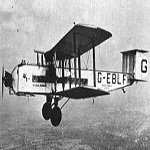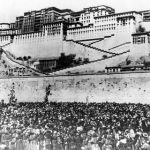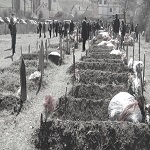 1933 – Liverpool’s Imperial Airways freighter is believed to be the first lost and sabotaged aircraft when a passenger fires on board. All 15 people on board died, making it one of the deadliest accidents in British civil aviation history by that time. The suspect was centered on a passenger, Albert Voss, who apparently jumped out of the plane before crashing.
1933 – Liverpool’s Imperial Airways freighter is believed to be the first lost and sabotaged aircraft when a passenger fires on board. All 15 people on board died, making it one of the deadliest accidents in British civil aviation history by that time. The suspect was centered on a passenger, Albert Voss, who apparently jumped out of the plane before crashing.
 1946 – During the Cold War, the United States Department releases the Acheson-Lilienthal Report, outlining a plan for international nuclear power control. He proposed international control of nuclear weapons and the avoidance of future nuclear war. Fortunately, this document was taken into account in the future as many states that possessed nuclear weapons reduced them.
1946 – During the Cold War, the United States Department releases the Acheson-Lilienthal Report, outlining a plan for international nuclear power control. He proposed international control of nuclear weapons and the avoidance of future nuclear war. Fortunately, this document was taken into account in the future as many states that possessed nuclear weapons reduced them.
 1951 – During the First Indochina War, at the Battle of Mao Khe, French Union forces led by World War II hero Jean de Lattre de Tassigny inflict a loss on Viet Minh forces commanded by General Vo Nguyen Giap. The victory of the French Union, however, was not decisive and the Viet Minh troops would attack again shortly thereafter.
1951 – During the First Indochina War, at the Battle of Mao Khe, French Union forces led by World War II hero Jean de Lattre de Tassigny inflict a loss on Viet Minh forces commanded by General Vo Nguyen Giap. The victory of the French Union, however, was not decisive and the Viet Minh troops would attack again shortly thereafter.
 1959 – The State Council of the People’s Republic of China dissolves the government of Tibet. The armed conflict between the Tibetan rebels and the Chinese military (PLA) broke out in 1956 in the Kham and Amdo region, which had undergone socialist reform. Guerrilla warfare later spread to other areas of Tibet. It would cease in 1959 when the US withdrew its support for Tibetan rebels.
1959 – The State Council of the People’s Republic of China dissolves the government of Tibet. The armed conflict between the Tibetan rebels and the Chinese military (PLA) broke out in 1956 in the Kham and Amdo region, which had undergone socialist reform. Guerrilla warfare later spread to other areas of Tibet. It would cease in 1959 when the US withdrew its support for Tibetan rebels.
 1969 – Greek poet and Nobel laureate Giorgos Seferis makes a famous statement at the BBC World Service, which strongly opposed the military junta in Greece. Following widespread censorship, political detention and torture, Seferis took a stand against the regime. He made a statement to the BBC, with copies distributed simultaneously to every newspaper in Athens. He stated, “This anomaly should end.”
1969 – Greek poet and Nobel laureate Giorgos Seferis makes a famous statement at the BBC World Service, which strongly opposed the military junta in Greece. Following widespread censorship, political detention and torture, Seferis took a stand against the regime. He made a statement to the BBC, with copies distributed simultaneously to every newspaper in Athens. He stated, “This anomaly should end.”
 1979 – A refrigerant leak at the Three Mile Island Unit 2 nuclear reactor outside Harrisburg, Pennsylvania leads to substantial overheating and partial melting. This was the most significant accident in the history of US nuclear power plants. At the scale of the seven-point International Nuclear events, the incident was rated no. five as “an accident of wider consequences”.
1979 – A refrigerant leak at the Three Mile Island Unit 2 nuclear reactor outside Harrisburg, Pennsylvania leads to substantial overheating and partial melting. This was the most significant accident in the history of US nuclear power plants. At the scale of the seven-point International Nuclear events, the incident was rated no. five as “an accident of wider consequences”.
 1986 – Born in New York, Lady Gaga. Lady Gaga is an American singer and actress. She is known for recreating herself throughout her career and for her versatility in numerous areas of the entertainment industry. She rose to prominence with her debut album, The Fame, and the songs at the top of the charts “Just Dance” and “Poker Face”. The album was republished as The Fame Monster, which included “Bad Romance”, “Phone” and “Alejandro”.
1986 – Born in New York, Lady Gaga. Lady Gaga is an American singer and actress. She is known for recreating herself throughout her career and for her versatility in numerous areas of the entertainment industry. She rose to prominence with her debut album, The Fame, and the songs at the top of the charts “Just Dance” and “Poker Face”. The album was republished as The Fame Monster, which included “Bad Romance”, “Phone” and “Alejandro”.
 1994 – Eugene Ionesco dies at the age of 85. Ionesco, was a Franco-Romanian playwright, writing mainly in French, and one of the most prominent figures in the French Avant-Garde theater. Beyond mocking the banalest of situations, Ionesco’s plays depict the loneliness and insignificance of human existence in a tangible way. Ionesco is decorated with many medals for its scenic side.
1994 – Eugene Ionesco dies at the age of 85. Ionesco, was a Franco-Romanian playwright, writing mainly in French, and one of the most prominent figures in the French Avant-Garde theater. Beyond mocking the banalest of situations, Ionesco’s plays depict the loneliness and insignificance of human existence in a tangible way. Ionesco is decorated with many medals for its scenic side.
 1999 – The Izbica massacre was one of the largest massacres committed by Serbs during the Kosovo War, in 1999, in the municipality of Skenderaj. Although the exact number of Albanian victims is unknown, according to interviews with some people who had buried the dead, it is said that there are between 146 and 166 bodies. The killings were also cited in the indictment filed by Slobodan Milosevic and others’s war crimes tribunal, published on May 26, 1999. The isolated farm group had attracted the attention of war crimes investigators and Western officials. So, Izbica is among the 43 locations in Kosovo that NATO and US officials have identified as possible locations for mass graves. Also, satellite images released by NATO confirmed these cemeteries in three lines. Even ethnic Albanian refugees had presented to the United Nations, independent investigators and monitors, their testimonies of what happened in Izbice. In fact, there were many different statements and reports which speak of this massacre, but also discrepancies between them due to different versions. Therefore, Izbica was a complex task faced by investigators.
1999 – The Izbica massacre was one of the largest massacres committed by Serbs during the Kosovo War, in 1999, in the municipality of Skenderaj. Although the exact number of Albanian victims is unknown, according to interviews with some people who had buried the dead, it is said that there are between 146 and 166 bodies. The killings were also cited in the indictment filed by Slobodan Milosevic and others’s war crimes tribunal, published on May 26, 1999. The isolated farm group had attracted the attention of war crimes investigators and Western officials. So, Izbica is among the 43 locations in Kosovo that NATO and US officials have identified as possible locations for mass graves. Also, satellite images released by NATO confirmed these cemeteries in three lines. Even ethnic Albanian refugees had presented to the United Nations, independent investigators and monitors, their testimonies of what happened in Izbice. In fact, there were many different statements and reports which speak of this massacre, but also discrepancies between them due to different versions. Therefore, Izbica was a complex task faced by investigators.






